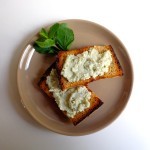 Fromage fort translates literally as ‘strong cheese’, but — in a country known for its many strong cheeses — that does not begin to convey the pungency of this spread of aged cheeses, garlic and eau-de-vie. It could more rightly be called ‘knock-your-socks-off cheese’. I first discovered it at a Paris wine bar called La Tartine, where it was served on slabs of dense country bread, with a glass of sturdy Bordeaux or Côtes du Rhône on the side.
Fromage fort translates literally as ‘strong cheese’, but — in a country known for its many strong cheeses — that does not begin to convey the pungency of this spread of aged cheeses, garlic and eau-de-vie. It could more rightly be called ‘knock-your-socks-off cheese’. I first discovered it at a Paris wine bar called La Tartine, where it was served on slabs of dense country bread, with a glass of sturdy Bordeaux or Côtes du Rhône on the side.
Fromage fort / Pungent French cheese spread
But what, exactly, is fromage fort? Traditionally, it was a way of preserving cheese that had dried out or become so strong as to be unpalatable. Some will tell you it arose in Burgundy, where rich and wonderful cheeses like Epoisses are produced (it’s a creamy cheese from cow’s milk that is washed in marc de Bourgogne, the local eau-de-vie). But in fact there are as many recipes for fromage fort as there are corners of France. In the south it is often made with goat cheese, near the Swiss border it is made with gruyère, and in the rugged Auvergne region of central France it is made with blue cheese.
The names of these various versions could form a geographical dictionary of French culinary inventiveness. There is le brous (aka le cachetti) from the foothills above Nice; le miromando (served with blueberries) from Ardèche, west of the Rhône; le casgiù merzu from Corsica (fermented with larva), and — believe it or not — a cheese called le pourri bressan, which translates as ‘rotten cheese from Bresse’.
I wanted to track down a bona fide recipe for fromage fort, so I stopped by at La Tartine last week to chat with the chef. Unfortunately La Tartine changed ownership a few years back, and it is no longer served there. (In fact, it is rare these days to find fromage fort on any bistro menu — an excellent reason, if any was needed, to make it oneself. ) But the current owner, Bernard Séguis, was happy to share his recipe — a Burgundy version that incorporates a broth made of the whites of leeks into the mixture. He suggested serving the spread accompanied by walnuts or slices of pear.
My modernized version omits the broth. And you don’t need to wait for your cheese to get old in order to make it. The spread can be whipped up in a matter of minutes and served with wine during cocktail hour, at lunchtime as an open-faced sandwich (une tartine) or as a cheese course after a larger meal. Be sure to have some sturdy red standing by.
Happy cooking!
Food writing competition: My friend Jonell Galloway, author of the web site The Rambling Epicure, is sponsoring a competition for newcomers to food writing. If you’ve ever wanted to try your hand at writing on food-related subjects — fiction or nonfiction — click here for details.




Now that takes me back. We have that extraordinary concoction here. One of our former mayors is forever opening the bocal and we all get a blast of very aged goats cheese with the local eau de vie called gnole. Melts your eyebrows.
Hello. I am happily addicted to your website, not only for your wonderful explanations about the dishes you offer up, but for your musings about events in France, for example, Hollande’s attempt to change the school curriculum. Anyhow, I have two published mystery novels, one set in Champagne, and the other in Bordeaux. I will traveling to Burgundy late fall to explore and to be inspired, though the first draft of BURGUNDY will have been written. I include quite a lot of food and wine in the novels, and would love to meet you when I come, if possible. If I used any of your recipes, or advice, I would give you credit in the acknowledgments. No matter, I would love to meet the author of these blogs. (I live in Vermont.) Warmly, Janet
Dear Janet,
Thank you for your lovely note. I would be delighted to meet you when you come, and in fact I know a little bit about Burgundy as we have a cottage down there. I will be in touch with you via email so that we can set this up.
All best, Meg